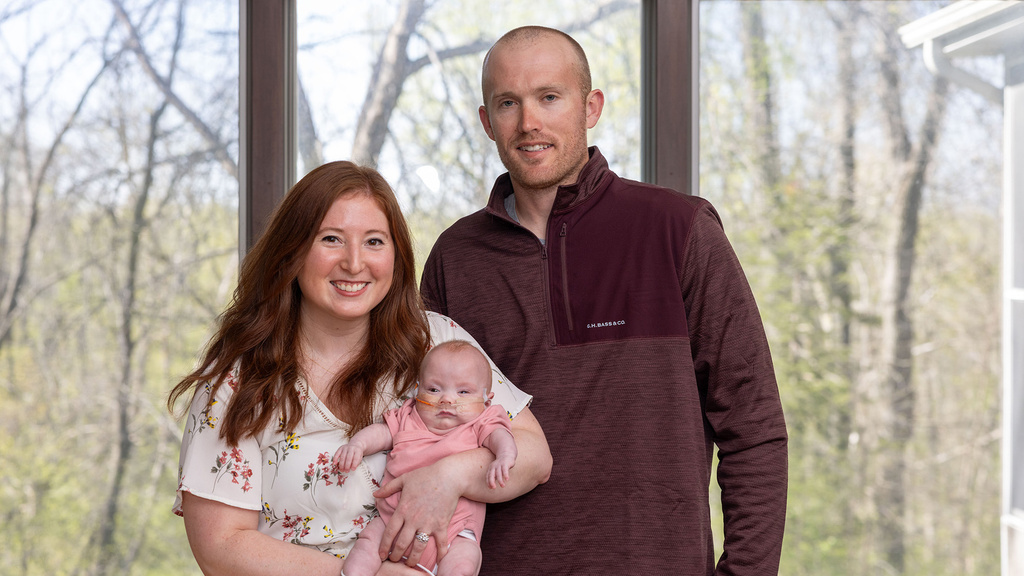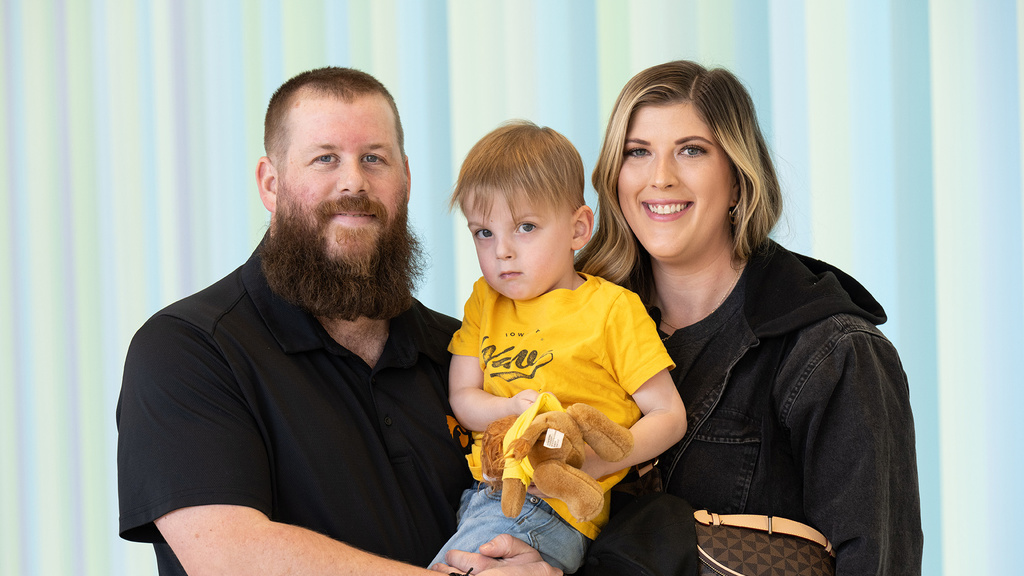For nearly three years, Aidan Moles knew no other home than UI Health Care Stead Family Children’s Hospital. The unique lifesaving care he received there allowed him to at last head home and start experiencing the everyday joys of life.
Story: Molly Rossiter
Photography: Susan McClellen
Published: May 4, 2021
Aidan Moles’ kidneys were failing, and his lungs were not giving him the oxygen he needed as a newborn. He had been born seven weeks early, and doctors weren’t sure if he would survive.
For 946 days, Aidan’s home was University of Iowa Health Care Stead Family Children’s Hospital. He never rode in a car, or went to a grocery store or day care center. He’d never heard the sound of a dishwasher or the ringing of a doorbell. He’d never been to a park, or a zoo, or a swimming pool. He’d never been to his Fort Madison, Iowa, home.
When Aidan was born July 5, 2018, he weighed 4 pounds, 10 ounces. He was in end-stage renal disease, requiring dialysis at birth. He was also diagnosed with pulmonary hypertension and spent most of his first two and a half years on oxygen. He fought infections, a heart problem, and some blood issues, until getting a new kidney in November 2020.
With a send-off befitting royalty — a parade through the halls of his hospital floor that was lined with members of his care team, signs, songs, tears, and smiles — Aidan went home for the first time on Feb. 5, 2021.
His kidney transplant, says Lyndsay Harshman, MD, MS, was Aidan’s turning point, but getting him to that transplant was no easy feat.
“There were times we weren’t sure he would make it, to be honest,” says Harshman, medical director of the pediatric kidney transplant program at Stead Family Children’s Hospital, the only such program in Iowa. “But his new kidney is doing such amazing things for his body that he doesn’t have the disturbances in his fluid balance to his body. He’s off of his ventilator. He’s going home without dialysis and without a ventilator.”
While kidneys are an important organ in general, they are especially vital for babies, Harshman says.
“The kidneys are like a vacuum cleaner — they clean your blood to make urine,” she says. “For a baby developing in utero, that urine is a really important part of the amniotic fluid that the baby is growing in and is cushioned in — as the baby is learning to breathe in utero they breathe that in and swallow that fluid, and it nourishes the lungs and helps them to develop.”
Doctors discovered in prenatal ultrasounds that Aidan’s kidneys were likely abnormal, but they wouldn’t know their true condition until he was born. That’s when they discovered he was born with dysplastic kidneys, meaning the kidneys were barely functioning. As a result, his lungs were also poorly developed, setting the stage for pulmonary hypertension, a type of elevated blood pressure that affects the arteries in the heart and lungs.
“It makes the heart work harder, and the baby can get quite sick,” Harshman says. “So not only did Aidan not have kidneys that worked, but he had lungs that were less well-formed than other babies, and he had this abnormal resistance in his heart and lung vessels. He had a lot of things going on right from the start.”
Aidan’s care team knew fairly early that a kidney transplant was going to be key — but they also knew his tiny body wasn’t ready for such a demanding surgery. His heart and lungs needed to get much stronger, and the type of dialysis he was on initially — peritoneal dialysis — was causing infections around the catheter site in his stomach. He was switched to continuous renal replacement therapy (CRRT), a much more intensive form of dialysis.
CRRT carries its own risks for infants; the machine has to be primed and constantly monitored so it doesn’t cause a serious blood loss for the baby.
“We have to really think very carefully about when we start a baby on CRRT — is the baby stable enough, do we have the proper support — so our dialysis nurses are lifesavers,” Harshman says.
When Aidan was started on CRRT he was intubated to help his heart and lungs work and develop and was sedated for a few months because he was so critically ill.
“It was at this point in his little life that we had a very tough discussion as a team: Are we doing more to help him or are we actually hurting Aidan by continuing to offer therapies?” Harshman recalls. “We all continued to agree as a group that look, we can see a dim light in this tunnel. So we continued to take baby steps every single day of every single week.”
A few months later, the care team determined Aidan had gotten to the point of being infection-free long enough that they could try to switch him back to peritoneal dialysis — and it worked. After nearly a year in the NICU, Aidan was moved to an inpatient floor. Once his team thought his heart and lungs had gotten strong enough, he was placed on the transplant list.
Then the lifesaving kidney came in November.

“I feel very fortunate and very blessed that he was born where he was. It just makes me realize how fortunate and how blessed we are that he got such wonderful care and that he’s been so strong and made it through all of this.”
A turning point
“I think one of the things that people sometimes ask is given the fact that we have so many people waiting for kidneys, is it appropriate to use it in a child who is facing so many challenges?” says pediatric kidney transplant surgeon David Axelrod, MD. “It’s important to know that once they get these kidneys some of those things that seem to be barriers no longer exist. They get markedly better in ways people don’t even expect.”
Aidan was no exception. In fact, Harshman says she and other members of his care team were continuously surprised at the speed of Aidan’s developments.
“He completely exceeded all of my expectations,” she says. “We had no timetable for what to expect, but within that first month after transplant it became very clear: Aidan was absolutely driving this boat. He was standing up in his crib within days of his transplant and he’d never been able to do that before. He was just making all these strides.”
Now that he’s home, Aidan’s biological-grandmother-turned-adoptive-mother Aron Donaldson says he is continuing to thrive. He’s learned to crawl, and is pulling himself up onto furniture.
“He is doing so well, he’s just everywhere, you can’t stop him,” Donaldson says. “He wants to do everything.”
She’s taken him to the park — he loves the swing — and on several walks. Aidan loves to watch the other kids at the park, she says, and she enjoys watching him take it all in.
Still, she doesn’t forget how far he’s come.
“I see stories of kids who have gone through less and not made it and I think, ‘Wow, how strong is this little guy to have gone through some really tough stuff,’” she says. “And there were times they told us they didn’t think he was going to make it. But here we are.”
When reflecting on how Aidan may have had a much different outcome without the care he received at Stead Family Children’s Hospital — home of the state’s only pediatric kidney transplant program, Donaldson says, “I feel very fortunate and very blessed that he was born where he was. It just makes me realize how fortunate and how blessed we are that he got such wonderful care and that he’s been so strong and made it through all of this.”



